A. INTRODUCTION OF CHARGER (KSBC) FOR FLOODED LEAD ACID FORKLIFT BATTERY
KSBC
is the charger for flooded lead acid forklift batteries and was designed on the
basis of many years of our research and experience by GS Yuasa to assure
automatic charging in proper, efficient ways. Therefore, troublesome battery
charging work can be omitted.

This product is manufactured by the official supplier of GS Yuasa, distributed by GS Battery Viet Nam (GSV) with technical support from GS Yuasa Japan.
Contact for more information: salesibs@gsbattery.vn
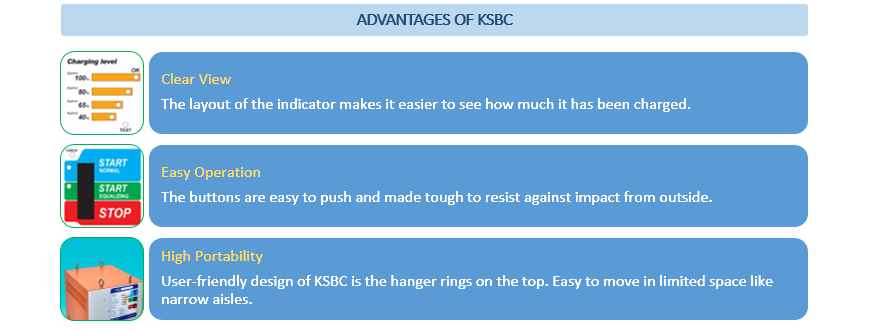
B.
TRACTION BATTERY CHARGER ADVICE
I – Choose the suitable charger
It’s very
important and affect to the lifespan of batteries.
If End-users
use the charger has a low charging current, the charging time will increase, it
makes the overcharging. Otherwise, if End-users use the charger has a high
charging current, the charging time will not be enough, the undercharging
happens.
The table
as bellow, this is the specification of KSBC charger – official supplier GS
Yuasa, it gives us an example of choose the suitable charger based on battery
capacity:
|
Model
|
Voltage
|
Battery
capacity (5HR)
|
Dimension
W
x H x D (mm)
|
Mass
|
|
KSBC
- #T48V45ASC
|
48 V
|
190 ~ 250 Ah
|
423.2 x 392 x 470
|
42 kg
|
|
KSBC
- #T48V60ASC
|
48
V
|
250
~ 330 Ah
|
423.2
x 392 x 470
|
52
kg
|
|
KSBC
- #T48V80ASC
|
48 V
|
330 ~ 450 Ah
|
423.2 x 392 x 470
|
57 kg
|
|
KSBC
- #T48V100ASC
|
48
V
|
440
~ 560 Ah
|
423.2
x 392 x 470
|
67
kg
|
|
KSBC
- #T48V130ASC
|
48 V
|
560 ~ 730 Ah
|
423.2 x 392 x 470
|
77 kg
|
|
KSBC
- #T80V80ASC
|
80
V
|
330
~ 450 Ah
|
453.2
x 442 x 570
|
85
kg
|
|
KSBC
- #T80V100ASC
|
80 V
|
440 ~ 560 Ah
|
453.2 x 442 x 570
|
100 kg
|
#: The value of input voltage (2 or 4):
2: 3 phase, 200 V AC series
(200 V/210 V/220 V/230 V)
4: 3 phase, 400 V AC series
(340 V/360 V/380 V/400 V/420 V/440 V/460 V)
If the
available chargers of End-user are not matched with specification as above.
End-users consider to purchase or borrow chargers as battery
manufacturer’s requirements.
II – The right charging operation
Chargers have 2
mode of charging: normal and equalizing. End-users contact to supplier to
identify the right its starting way. In this content,
we use these pictures in Operation Guide of KSBC.
1. Normal
charging
Ensure the
connection between charger and battery, press the starting button. Base on the
voltage of battery, charger will supply the current until full-charged.
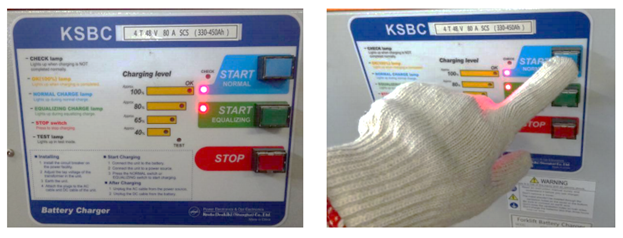
2. Equalizing
charging
After 3 ~ 4
week of using, there is a small difference of voltage and Sp.G in single cells,
we need to use the equalizing charging at that time.
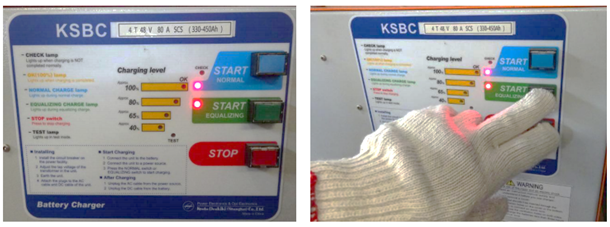
Base on the
working capacity, we can change the frequency of equalizing charging. Contact
to supplier for consultant.
3. Some
remarks in before, during and after charging
Before charging:
-
Check
the input voltage of charger:
o
3
phase, 200 V AC series (200 V/210 V/220 V/230 V)
o
3
phase, 400 V AC series
(340 V/360 V/380 V/400 V/420 V/440 V/460 V)
-
Check
the electrolyte level:
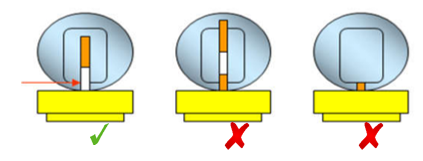
- Consider using the distilled water
of GS for filling in case lack of electrolyte.
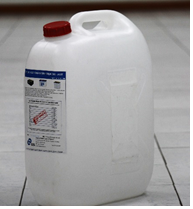
-
Ensure
the connection is completely
During charging:
-
Temperature
of electrolyte is not over 55oC
-
The
vent plug should not open.
-
Charging
area need to be well ventilated, prevented from any activity that causes spark
or fire or electrostatic.
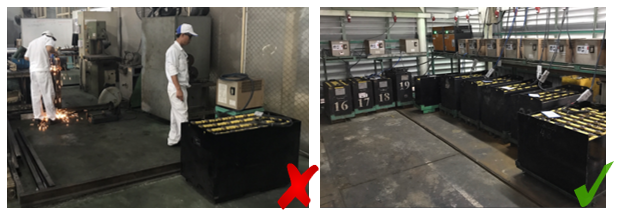
After charging:
-
Battery
should have time to decrease the temperature (35 ~ 45oC)
-
Ensure
battery achieves full-charged status in every time.
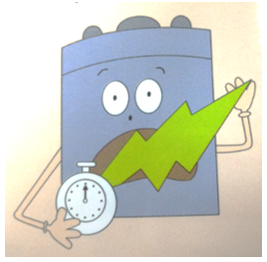
-
Do
not charge in break time of working shift. If yes, please make sure batteries
get the full-charged or End-users need some back-up batteries for operation.
III – Remarks
-
Do
not use manual charger instead of automatic charger
-
Do
not use a charger for many batteries with the different capacity
-
Checking
the charger (1 time/year) to ensure its ability
-
Stop
charging immediately when occurring smoke or temperature exceed 55oC
-
Do
not repair charger or replace spare part without permission
from charger manufacturer.